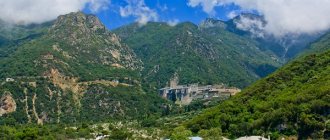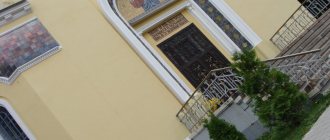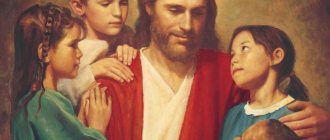An unheard of scandal occurred in Greece in 1930, the culprit of which was the winner of the Miss Europe contest, eighteen-year-old Greek Aliki Diplarakou.
Dressed as a man, she entered the Holy Mount Athos and visited monasteries.
She was nicknamed Satan after this incident. A severe illness that soon overtook her forced the girl to rethink her life and repent of what she had done.
In her letter to the clergy and the brethren of the monasteries of the Holy Mountain, sincerely repenting, she asked to forgive her daring act.
“Reverend fathers, I want to confess and repent with all my soul for my mistake,
done by me...
I put on my fiancé’s clothes and went around temples and other places with him...
Since then, dear fathers, I have lost my health...
However, I have come to know and am firmly convinced
that this is the punishment of the Most Holy Theotokos,
To whom I showed my disrespect..."
Alika Diplaraku
repentant Greek woman
The Lord accepted Alika’s repentance and gave her healing. She died at the age of 90 in 2002.
For almost a millennium, Athos has been a forbidden territory for women.
This is the only place on earth where representatives of the fair sex are officially prohibited not only from being, but even from approaching the coast of the peninsula closer than 500 meters.
Holy Mount Athos is the habitat of Orthodox monks, where women are forbidden to be
Athos is an autonomous monastic republic within the Greek state, on which there are 20 ruling monasteries and many hermitages.
This is the largest Orthodox community in the world. A sacred place for all Christians. Why are women not allowed to be in this place, which is considered the lot of the Virgin Mary?
Is no one offended?
How widespread is dissatisfaction among church women with the place the Church assigns them? We asked several prominent Orthodox women about this. Let’s be honest: when we started our survey of Orthodox compatriots, we expected that the successful, professionally accomplished women who had fulfilled their calling, who we had chosen, felt more keenly than others and were better able to express the women’s resentment that was heard in the letter from the Church Abroad. To our surprise, there was not a single offended person among our interlocutors! Maybe the fact is that in the Church any conversation from the position of “I have the right” is completely unfruitful? None of us - men or women, it doesn’t matter - can demand anything “for ourselves” - because love does not seek its own. You can only demand from yourself. How good it is that it is easier for the feminine, softer and more compliant nature to understand this! What should those who are still offended do: men won’t let them say a word? I think there is some consolation. If you really have something to say, and the content of your soul and your words is really important, you don’t have to be afraid, you will be heard. How the holy women were heard - so much so that the memory of them and their words were preserved through the centuries. The topic “woman in the Church” cannot be limited to one issue. About what is the true calling of women and whether it is the same for everyone, why active social or church activities are dangerous for her, whether her life is detrimental if she is not married, why it is now so difficult to find a “other half” - read this in the following room of Neskuchny Garden.
Yulia Danilova
Boring Garden
The Virgin Mary, finding herself on the Holy Mountain, asked the Lord to give her the land of Athos as her inheritance
According to church tradition, when in Jerusalem, in the Zion upper room, the apostles cast lots to whom in which country of the world would preach the Gospel teaching, the Mother of God also expressed a desire to go to preach.
And her lot fell on the land of Iveria (Georgia). But the Angel of God said to Her:
“The country that has fallen to You will subsequently be enlightened, and Your dominion will be established there; after some time has passed.
You have before you the work of preaching the gospel in the land into which God will direct you.”
Arrival of the Blessed Virgin Mary on the Athos Peninsula.
Lithograph In 49, the Mother of God, together with the apostles, went to the island of Cyprus to visit Bishop Saint Lazarus.
Their ship, caught in a storm, washed ashore near the Iveron Monastery, whose population was pagans.
49
the year when the Mother of God with the apostles went to the island of Cyprus, but ended up on the Land of Athos
The idol temples announced the truth to people with loud cries and began to call on everyone to accept the Mother of God.
Taking this as an instruction from the Lord God, the Virgin Mary came ashore and preached the Gospel to the inhabitants, showing miracles. Believing in her, everyone without exception accepted holy baptism.
The beauty of these places struck the Most Holy Theotokos, and she turned to the Lord to give her the Land of Athos as her inheritance. God granted her wish.
Since then, the Athos peninsula also began to be called the earthly inheritance of the Virgin Mary or “Garden of the Virgin Mary.”
Blessed Virgin Mary - Abbess of Holy Mount Athos
According to the covenant of the Virgin Mary, no woman can enter Athos; only she alone could represent her gender on the peninsula.
In the 5th century, according to legend, the daughter of the Byzantine Emperor Theodosius I, Placidia, went to the Athos peninsula to look at the monastery built by her father.
Approaching the temple, she heard the voice of the Mother of God, ordering her to leave the Holy Mountain and not to embarrass the monks if she considered herself a righteous Christian.
Plakidia, amazed by what had happened, immediately left the island.
The horrors of Domostroy are exaggerated
For some reason, it is believed that all the horrors of traditional family life are described in “Domostroy” - a Russian family charter of the 16th century (the famous priest Sylvester was the author of only one of the editions of “Domostroy”). However, in this book we find only one quote that can be interpreted as encouraging corporal punishment for women: “If the husband saw that his wife was in disarray and the servants, or that everything was not as described in this book, he would be able to instruct his wife and teach her useful things.” advice; if she understands, then let her do everything like that, and respect her and favor her, but if the wife is such a science, does not follow the instructions and does not fulfill it (as is said in this book), and she herself does not know any of this, and the servants do not teaches, a husband must punish his wife, admonish her with fear in private, and having punished her, forgive and reproach, and gently instruct, and teach, but at the same time neither the husband should be offended by his wife, nor the wife by her husband - always live in love and harmony.”
Female representatives have repeatedly violated the ban
During the period of internecine war in Greece at the end of the first half of the 20th century, residents of neighboring villages raided the Athos lands in search of livestock and food.
Among them were representatives of the fair sex.
1953
This year, Greece passed a law criminalizing women entering the Holy Mountain.
In 1953, the Greek woman Maria Poimenidou, dressed in male attire, entered the territory of Athos, where she stayed for three days.
It was this incident that prompted the Greek government to pass a law banning women from entering the Holy Mountain.
Those who violate it face criminal liability.
In 2008, police detained four women from Moldova who were landed on the Athos peninsula by illegal carriers. They were released because they were forgiven by the monks.
It is worth noting that in Greece the ban on women visiting monasteries was preserved not only on Athos. Women are not allowed to enter most monasteries.
Where did the deaconesses go?
Deaconesses as a special female church ministry appeared around the 4th century after the Nativity of Christ (although Deaconess Thebes is mentioned in the Epistle of the Apostle Paul to the Romans, historians believe that at that time the rite of becoming a deaconess had not yet been established). In the subsequent Byzantine tradition, unmarried women over 50 years of age could become deaconesses: widows, virgins, and also nuns. The order of the rites of ordination of a deaconess and a deacon was almost the same (but the prayers of ordination, of course, were different) - at the end of the ordination the deacon was given the Chalice, and he went to give communion to the believers, and the deaconess put the Chalice back on the Holy. throne. This expressed the fact that the deaconess had no liturgical duties (the only known independent role of deaconesses in worship was related to maintaining decency during the Baptism of women: after the bishop or priest poured holy oil on the forehead of the baptized person, the rest of the body was anointed by the deaconess). Deaconesses performed administrative functions in charitable institutions and led women's communities. In Byzantium, deaconesses existed until the 11th century (by this time only schema-nuns could become deaconesses); in the West, they disappeared about half a millennium earlier - largely due to the destruction of the social structure within which they were required. In Byzantium, the need for deaconesses disappeared for similar reasons - social charitable institutions no longer needed them. Later, the institution of deaconesses was not restored, since there was no need for them. True, several deaconesses were ordained by St. Nektarios of Aegina (1846–1920), the founder of a convent on the Greek island of Aegina, but this experience was not continued. There have never been deaconesses in Russia - in the oldest Slavic manuscript of the rites of ordination (bishop's Trebnik RNL. Sof. 1056, 14th century) the rite of ordination of a deaconess is absent.
Neglect and infringement of women's rights?
No! On the part of the Afonites, this is just a desire to protect and preserve the established way of life.
Athos is a special place, just like thousands of years ago, life here follows its own laws - constant work and prayer. Far from worldly temptations, in order to be closer to the Lord.
There are cases when the ban was temporarily lifted by monks. During the period of the Turkish invasion and civil strife in Greece from 1946 to 1949, they provided assistance to refugees, including women, by providing shelter.
How to get there for men
Representatives of the stronger sex who decide to visit holy places need to receive diamonitirion. Only 120 permits are issued per day. Foreign citizens will require additional permission from the Ministry of Macedonian and Thrace Affairs. Pilgrims can stay on Mount Athos for up to 30 days, but this requires a special certificate from the department for foreign citizens.
Can women venerate the shrines of Athos and not violate the ban?
Every day, early in the morning, a pleasure boat departs from Ouranoupolis, which goes around the shore of Holy Mount Athos at a distance of half a kilometer. Not only men, but also women can become passengers.
This is not just a walk - it is a pilgrimage, the only opportunity for representatives of the fair half of humanity to see and worship the shrines of Athos.
Women can touch the shrines by taking a ride on a cruise boat that goes around Mount Athos along the shore at a distance of half a kilometer
During the cruise, the boat moored to one of the piers, not far from the St. Panteleimon Monastery.
Monastery of Russian monasticism on Mount Athos. Monks come aboard to join the pilgrims, bringing with them miraculous shrines.
The miraculous icon of the All-Tsaritsa, which is shown to pilgrims of Athos
For example, the belt of the Blessed Virgin Mary from the Vatopedi monastery. Prayer to the Blessed Virgin at this shrine has helped many women heal from infertility. The miraculous icon “The Queen of All” helps cancer patients cope with the disease.
A particle of the Life-giving Cross of the Lord, part of the head of the great martyr and healer Panteleimon, the right hand of the great martyr George the Victorious and the relics of St. Mary Magdalene are brought by monks from the Xenophon monastery.
The monks of the Dionysiata Monastery give women the opportunity to venerate the relics of the Forerunner of the Lord John.
A cruise along the shores of the Holy Mountain is not the only opportunity for women to see and touch the shrines kept on Mount Athos.
They can also visit the land border with the autonomous republic not far from the foot of the Holy Mountain.
Just a rib or the whole half?
According to one interpretation of the Bible, God created woman not from the man Adam, but from the man Adam, dividing him into two halves: male and female. Metropolitan Anthony of Sourozh comments on this passage: “Translations of the Bible often say that God took Adam’s rib (Gen. 2:21). The Hebrew text offers other translations, one of which speaks of a side rather than an edge. God did not separate the rib, but separated two sides, two halves, female and male. Indeed, when you read the text in Hebrew, it becomes clear what Adam is saying when he comes face to face with Eve. He exclaims: She is a wife, because I am a husband (Gen. 2:23). In Hebrew it sounds: ish and isha, the same word in the masculine and feminine. Together they make up a person, and they see each other in a new richness, in a new opportunity to grow what is already given into a new fullness.
Athos is an autonomous monastic republic, with its own laws, traditions and governance system
Monks have inhabited Athos since the first centuries of Christianity. The mild climate of Athos, the beauty and amazing topography of these places favored a solitary life.
Today, the current inhabitants of the Holy Mountain continue to honor thousand-year-old traditions.
Every day, for many centuries, up to 300 liturgies are celebrated on Mount Athos before sunrise.
All peoples who adhere to the Orthodox tradition are represented here - Greeks, Bulgarians, Serbs, Russians, Georgians.
They all live together on the peninsula.
1 000
so many years ago the first Russian monks appeared on Mount Athos
The first Russian monks appeared on Mount Athos a thousand years ago.
The monasteries of the Most Holy Theotokos Xylurgu, Thessalonian and St. Panteleimon Monastery are the abode of Russian monasticism on Athos.
One of the monasteries of Russian monasticism on Mount Athos - St. Panteleimon Monastery
The rector of the Russian St. Panteleimon Monastery is Hegumen Archimandrite Evlogiy (Ivanov).
The abbot is not only the most important figure in the monastery, but also a kind of governor of the territory under his control.
For monks, the abbot represents Jesus Christ, and his task is to help them in spiritual growth.
Great Lavra, the premier monastery on Mount Athos
Today there are two dozen monasteries on Mount Athos, among which a strict hierarchy has been established. The main place is occupied by the Great Lavra.
Monasteries on Mount Athos have magnificent architecture, luxurious frescoes, amazing shrines, miraculous icons.
Athos is considered one of the inheritances of the Mother of God, lands that are under the special protection of the Mother of God, therefore, since ancient times, numerous pilgrimages have been made to the sacred land.
Pilgrims, having received permission to enter, reach Mount Athos by sea
But getting here is not easy; every pilgrim must obtain an entry permit in advance - daimonitirion. Only male persons can receive it.
According to one of the legends, if the centuries-old ban on women visiting Holy Mount Athos is lifted, the end of the world will come.
By leaving a comment, you accept the user agreement
Symbol of faith
Women, who are still prohibited from crossing the border of Athos, will have access to a unique spiritual and historical monument as a result of the implementation of the digital museum of Athos cultural heritage project worth 2 million euros, the portal greek.ru reports.
Article 186 of the Charter of the Holy Mount Athos ("Tragos") states: "In accordance with ancient custom, it is forbidden for any female creature to set foot on the peninsula of the Holy Mountain."
Only men of any religion are allowed to visit Mount Athos, who must obtain a special permit - dipmonitirion - to visit. For women entering the territory of Mount Athos, criminal liability is provided - up to 12 months of imprisonment.
It is planned that museum visitors will be able to appreciate the extraordinary wealth of the monasteries and enjoy the rare beauty of pristine nature, and will also have the opportunity to learn about the spiritual and everyday life of the inhabitants of the Holy Mountain and trace the entire history of Athos.
A three-dimensional display of exhibits in the digital museum will be available in two places at once. In the cultural center of Ierissos, which, in addition to traditional exhibition halls, also has an amphitheater with the most modern equipment for showing high-quality films in 3D format, and on the territory of the Zygou Monastery, which is the gateway to the monastic state.
The museum's exhibits will be divided into the following topics: the natural environment of the monasteries, the cultural richness of each monastery, and the daily life of the monks. Also here you can learn about the architectural features of monasteries, libraries, and miraculous icons.
Local authorities are proud of the idea of creating a digital museum of Mount Athos and hope that there will be many in the world who want to “feel” the spiritual atmosphere and get acquainted with the values of Orthodoxy, which have lived on this world monument of Christianity for centuries.
The Athonite monastic republic belongs to the Ecumenical Patriarchate. Despite this, it has virtually complete administrative independence from the throne of Constantinople and strictly preserves its internal independence. The patriarchal authority on Mount Athos is represented by the suffragan bishop.
REFERENCE
Woman on Mount Athos
Athos holds many secrets. Everyone knows that today the peninsula is a settlement of Orthodox monks. But in Ancient Greece, Athos was also considered a holy place; temples to Apollo and Zeus were built here. The sanctuary of the latter was called Afos, hence the name of the peninsula. Another feature of this island is that women are not allowed here. First, in order to understand such injustice, you need to know the history and customs of the local monks, and then I will tell you whether a woman has the opportunity to visit the peninsula.
History and myths
When the Greeks adopted Christianity, as the legend says, in 44 after the Nativity of Christ, the mother of Jesus along with the apostles went to the island of Cyprus, but on the way the ship got into a storm right next to Athos. As soon as the ship approached the shore, the pagan temples collapsed, and marble idols announced in human language the arrival of the Virgin Mary on the peninsula. Everyone who saw this miracle instantly believed and was baptized, and Athos itself has since become the earthly inheritance of the Mother of God. Then, according to legend, the icon of the Iveron Mother of God came to Athos by water. It is believed that when she leaves the Holy Mountain, the world will end.
But for a long time the settlement of Orthodox monks was small. The first large monastery was founded in 963 by Saint Athanasius of Athos, who is considered the founder of the entire way of monastic life adopted on the Holy Mountain. Now the monastery of St. Athanasia is known as the Great Lavra. And just half a century after its founding, in 1016, the first Russian monastery called Xylurgu appeared. Later, the monastery of St. Panteleimon was transferred to the Russian community.
At the time of its glory, Holy Athos included 180 Orthodox monasteries. The first monastic hermitages appeared here in the 8th century AD, and the republic received the status of autonomy under the auspices of the Byzantine Empire in 972. After several centuries, Byzantium lost its former strength under the pressure of the crusaders on the one hand and the Turkic tribes on the other... Athos had to exist independently, endure persecution from the papacy, and pay taxes to the conquerors of the region.
As a result, only 25 monasteries “survived”. Only in the middle of the 19th century, after the proclamation of Greek independence, did peaceful times begin for the Holy Mountain.
Russian monks appeared here during the time of the baptist of Rus', St. Equal-to-the-Apostles Prince Vladimir, and the Russian monastery on the site of the current Panteleimon Monastery was founded at the end of the 18th century. The monastery, which was once inhabited by 3 thousand monks (today there are only 40), houses the head of St. the Great Martyr Panteleimon, numerous holy relics, miraculous icons, priceless books and manuscripts.
There is a legend that since ancient times, 12 hermit elders have lived in secret cells on Athos, who almost never appear to people, even to the Athos monks themselves. If one of the elders dies, the rest bury him in the rocks and in return call for a new novice. According to legend, at the hour of the end of the world, these 12 elders will leave their cells and serve the last liturgy.
Now all the monasteries on Mount Athos live according to the laws and regulations that developed in the Byzantine era. Even the existing rules for visiting the Holy Mountain are based on the Golden Bull of the Byzantine Emperor Constantine the Monk (1060), which has been only slightly modified over the past millennium.
Despite the fact that at the beginning of the 20th century the Orthodox Church of Greece switched to the Gregorian calendar (new style), on Athos they continue to use the Julian calendar (old style), as in Russia.
Life and customs
Athos is an independent state. It is owned by a special Orthodox monastic association. Management is carried out jointly by representatives of each of the 20 monasteries. And the highest church power on Athos belongs not to the Patriarch of Athens, but to the Patriarch of Constantinople, as in the Byzantine era.
The life of monks in Athonite monasteries is spent in works and prayers; it is entirely devoted to serving God. Divine services are held in strict accordance with the charter in the morning and evening hours. In their free time from prayer, the monks cultivate the land, care for domestic animals, paint icons, and study the writings of the holy fathers of the Orthodox Church.
The monasteries of Athos are real museums of Byzantine times. These are majestic fortresses built right on the rocky mountain slopes, with thick impregnable walls to provide protection from enemies. Even during the wars, neither the Turks nor Nazi troops touched the monastery out of respect for the monks. That is why unique collections of ancient books, extensive libraries, collections of precious church utensils, priceless ancient frescoes and mosaics have been preserved in monasteries to this day. The most important Christian relics are also kept here: the belt of the Most Holy Theotokos, particles of the Venerable Tree of the Holy Cross, the incorruptible relics of saints, including the head of the holy martyr Panteleimon in the Russian monastery. The main Athonite shrine is the Gifts of the Magi, located in the Monastery of St. Paul. They were secretly transferred here from Constantinople after the fall of the Byzantine capital in 1453.
Women can join the Athos shrine only from afar, by sailing around the Athos peninsula. Motor ships departing from the city of Ouranoupolis sail off the southwestern coast of the peninsula at a distance sufficient to see the monasteries, including the famous Russian monastery of St. Panteleimon.
Those wishing to visit Holy Mount Athos must obtain a special permit - “diamonitirion”. Priests must have the blessing of the Ecumenical Patriarch or local bishop.
About women
Whether women were allowed or not allowed onto this island in ancient times is a controversial issue, since in the first typicon of the Holy Mountain, which is kept in Protata, Article 16 states that children, youths and eunuchs are prohibited from entering Athos - and, of course, All of them are forbidden to be tonsured as monks. Nothing is said about women here - but, most likely, it was implied that women in monasteries have nothing to do at all. The tradition of avaton (the so-called ban on women appearing on the island) was consolidated under Emperor Manuel II Paleologus at the beginning of the 15th century. That's the story. And most guidebooks will tell you that a woman has never set foot here.
True, there is a legend that at the beginning of the 5th century. Palakidia, the daughter of the Byzantine emperor Theodosius, returning from Rome to Constantinople, wished to settle the Holy Mountain and especially one of the monasteries built at the expense of her father. As soon as Placidia approached the entrance to the temple, she heard the voice of the Mother of God coming from the icon in the wall niche. The voice ordered Placidia to leave if she considered herself a virtuous Christian and did not want to tempt the monks with her presence. The shocked princess left, and entry has since been prohibited for women and even female pets. According to popular beliefs, birds do not build nests on Mount Athos and do not raise chicks, obeying the will of the Mother of God.
There is also a legend that in 1470, the Serbian princess Maro, the wife of Sultan Murat 1, arrived here on a luxurious ship. She brought rich gifts to the local inhabitants, but even she was not able to walk more than ten steps on this land. According to legend, an angel met her and asked her to return to the ship. She returned.
Local guides love to tell tourists a bloody tale about a French feminist who snuck onto the island in men's clothing. And when she realized that she was being mistaken for a man, she undressed and went swimming. Out of nowhere a shark appeared and dined on the brave but unlucky woman.
But this is a legend, but the truth is this: recently, many media outlets were making noise about the fact that illegal immigrants from Moldova accidentally ended up on the island of Athos. The shocked monks saw four beautiful young women on their land, after which they immediately called the police. When law enforcement officers arrived at the scene, it turned out that the beautiful women were natives of Moldova, 27-32 years old, who were trying to illegally move to Greece from Turkey. They were also accompanied by their 41-year-old male fellow countryman, who organized the trip. They said they paid $6,300 to Ukrainian smugglers living and working in Turkey and relied on their knowledge of local geography. But as a result, the company still got lost and landed on a lonely peninsula, which turned out to be Athos. The travelers apologized to the monks, saying they were unaware of local laws, and "the women were forgiven by the monks," police said. According to laws adopted in 2005, a lady who sets foot on Mount Athos can be sentenced to a year in prison. The law was also not adopted by chance, since in the age of feminism and emancipation it is very difficult to prohibit something for a woman.
Moreover, in addition to the ancient queens, the mythical Frenchwoman and runaway Moldovan women, a lot of women visited the island. Judge for yourself:
Among the oldest cases of violation of avaton, we note the sheltering of refugees on Athos after the so-called Oryol uprising in 1770, in 1821 - after the pan-Greek uprising against Turkish rule, in 1854 - after an unsuccessful uprising against the Turks in northern Greece. Refugees arrived with their families and took refuge on Mount Athos.
In 1931, the French journalist Marie Soisy spent a considerable time on Mount Athos and wrote a book about it, “A Month with Men” (the source of this information is not specified - author’s note). With the same goal of becoming famous, the first Greek woman to win the title “Miss Europe”, Aliki Diplarakou (1929) and Eleni Skoura (1932), the future first female deputy of the Greek Parliament, were also here.
In 1940, during the Greek-Italian war, refugees of both sexes came here from Kavala. In 1948, Eugenia Peiu, a 17-year-old member of a detachment of communist partisans, took refuge on Mount Athos after the defeat caused during the Greek civil war. Peyu recalled in an interview that when she realized where she was, she was overcome by fear and remorse. She refused to enter the monastery and was left on guard outside. The girl prayed all the time that an enemy would not appear in her field of vision and she would not have to attempt murder in a holy place.
In 1954, a group of women, specialists in Byzantine studies, disembarked from a boat ashore and walked to the fences of the monasteries. That same year, a Greek journalist secretly entered the Holy Mountain and wrote a series of articles about it for the newspaper.
In the late 60s, five tourists from France and Italy entered the territory of Mount Athos, and when detained, they stated that they knew nothing about the ban.
Finally, in 1989, a couple from Germany arrived on the rocky shore of the Simonopetra monastery and indulged in lovemaking there.
According to one of the bloggers who communicated with the famous Svyatogorsk Elder Augustine from the Skete of Agiou Vasiliou, he heard the following story from him: “During the Uprising, women found themselves on Mount Athos, and the monks of the monasteries to which they joined took advantage of this circumstance and adapted them for household work. And they liked it so much that they wanted to cancel the Avaton. For this purpose, they called the Kelliot hermits and ordered them to go with the appropriate embassy to the patriarch, threatening, if they refused, to deprive them of the allowance they received from the monasteries. They knew that the then monk-loving patriarch especially revered hermits. And so the Kellyots, although or unwillingly, went to the Patriarchate. But at the same time, a certain Svyatogorsk elder Arseny, who enjoyed deliberate authority with the patriarch, was in the City on some business of his own. And so, having received the delegation, the patriarch invited him to take part in the conversation. And when those elders expressed the wish of the Holy Mountain residents to abolish the avaton, the patriarch, being ready to agree with their arguments, nevertheless asked Arseny in order to dispel the last doubts. But he said: “If you leave women on the Mountain, holy lord, then the race of monks will multiply.” And then the patriarch refused the delegates.
The same o. Augustine told me: “If the avaton is canceled, we will leave the Mountain” - “But why, Geronda? After all, wherever you go, there will be women too, so what difference does it make then?” “You don’t understand: a decent woman won’t come here, but only whores will come to seduce monks.”
Here's the story. From which we can conclude that a very stubborn woman will still make her way to Athos.
What awaits ordinary women on Mount Athos is a sign “No women allowed” and tanned guys in open jeeps with machine guns mounted on the roof, looking out for adventurers in men’s dresses in the crowd of male pilgrims.
Several free campsites are specially set up outside the boundaries of the peninsula, a narrow strip of land 70 km long, for short-sighted travelers who take their wives or daughters with them. While waiting for the men, the ladies swim and sunbathe, while the latter, squeezing their shirts from sweat, climb with backpacks to a height of 2000 meters and kiss the icons at the very top of the Holy Mountain. On one side of the border they wear bikinis, on the other - men cannot even wear short shorts. It is forbidden to smoke and eat meat, play cards and listen to light music.
However, there are rumors that for the first time in centuries, women can gain access to one of the shrines of Mount Athos, a monastic state in northern Greece. According to the Greek Church News Agency, local authorities have decided to allow access to the Zigou monastery, the oldest monastery on Mount Athos, to everyone, including women.
The Zigu Monastery may be an exception to the rule, since it is located about forty meters outside the official border of Mount Athos, which women are prohibited from crossing. The monastery is located about two kilometers from the city of Ouranoupolis, where pilgrims begin their journey to Mount Athos, and is easily accessible to visitors.
The Byzantine monastery of Zigu, one of the oldest on Mount Athos, was first mentioned in chronicles under 942 AD. The monastery continued its existence until the end of the 12th century. The fortress walls of the monastery with eleven towers, as well as the ruins of the cathedral, built at the beginning of the 11th century, have remained to this day. Extensive excavations are currently underway here, carried out by the Greek Ministry of Culture.
Interesting:
When a monk dies, he is buried without a coffin, wrapped in a robe. A cross is placed over the grave. Three years after death, the body of the deceased is removed again. If it has decayed, it means that the ascetic has been forgiven and is in heaven. If the body does not decay, it means that the monk has passed on to another world with unrepentant sins. In this case, the body is buried for another year, during which they intensely pray for the salvation of the soul of the deceased. After this period, the body, as a rule, decays. Then the skull with a name inscribed on the forehead, or less often with a brief biography, is placed in the ossuary on special shelves. The remaining bones are piled in the corner of this crypt. Now in the ossuary of the Russian monastery there are 2040 skulls.
Like
SocButtons v1.5










